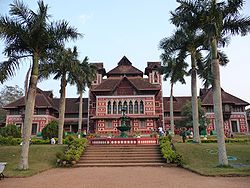
Napier Museum
Encyclopedia

Museum
A museum is an institution that cares for a collection of artifacts and other objects of scientific, artistic, cultural, or historical importance and makes them available for public viewing through exhibits that may be permanent or temporary. Most large museums are located in major cities...
situated in Thiruvananthapuram
Thiruvananthapuram
Thiruvananthapuram , formerly known as Trivandrum, is the capital of the Indian state of Kerala and the headquarters of the Thiruvananthapuram District. It is located on the west coast of India near the extreme south of the mainland...
(Trivandrum), the capital city of Kerala
Kerala
or Keralam is an Indian state located on the Malabar coast of south-west India. It was created on 1 November 1956 by the States Reorganisation Act by combining various Malayalam speaking regions....
, India
India
India , officially the Republic of India , is a country in South Asia. It is the seventh-largest country by geographical area, the second-most populous country with over 1.2 billion people, and the most populous democracy in the world...
.
History
The museum was established in 1855. In 1874, the old Museum Building was demolished and foundation for the new building was laid. The new building was named after Lord NapierFrancis Napier, 10th Lord Napier
Francis Napier, 10th Lord Napier and 1st Baron Ettrick, KT, PC , was a Scottish polyglot, diplomat and colonial administrator. He served as the British Minister to the United States from 1857 to 1859, Netherlands from 1859 to 1860, Russia from 1861 to 1864, Prussia from 1864 to 1866 and as the...
, the Governor of Madras from 1866-1872.
Design
The architectural masterpiece was designed by Robert ChisholmRobert Chisholm (architect)
Robert Fellowes Chisholm was a British architect who pioneered the Indo-Saracenic style of architecture in Madras.- Early life :Chisholm was born in London on January 11, 1840 and had his early education in the United Kingdom...
, the consulting Architect of the Madras Government
Madras Presidency
The Madras Presidency , officially the Presidency of Fort St. George and also known as Madras Province, was an administrative subdivision of British India...
and the construction was completed in 1880. Napier Museum is a landmark in the city with its unique ornamentation and architectural style with gothic
Gothic architecture
Gothic architecture is a style of architecture that flourished during the high and late medieval period. It evolved from Romanesque architecture and was succeeded by Renaissance architecture....
roof and minaret
Minaret
A minaret مناره , sometimes مئذنه) is a distinctive architectural feature of Islamic mosques, generally a tall spire with an onion-shaped or conical crown, usually either free standing or taller than any associated support structure. The basic form of a minaret includes a base, shaft, and gallery....
s.
The Indo-Saracenic
Indo-Saracenic
The Indo-Saracenic Revival was an architectural style movement by British architects in the late 19th century in British India...
structure also boasts a natural air conditioning system.
Features
The museum houses a rare collection of archaeological and historic artifacts, bronze idols, ancient ornaments, a temple chariotTemple car
Temple cars are chariots used to carry representations of Hindu gods. The car is usually used on festival days, when many people pull the cart....
and ivory carvings. It also contains the Sri Chitra Art Gallery, which contains works from Raja Ravi Varma
Raja Ravi Varma
Raja Ravi Varma was an Indian painter from the princely state of Travancore who achieved recognition for his depiction of scenes from the epics of the Mahabharata and Ramayana...
and Nicholas Roerich
Nicholas Roerich
Nicholas Roerich, also known as Nikolai Konstantinovich Rerikh , was a Russian mystic, painter, philosopher, scientist, writer, traveler, and public figure. A prolific artist, he created thousands of paintings and about 30 literary works...
, as well as examples of Mughal
Mughal painting
Mughal painting is a particular style of South Asian painting, generally confined to miniatures either as book illustrations or as single works to be kept in albums, which emerged from Persian miniature painting, with Indian Hindu, Jain, and Buddhist influences, and developed largely in the court...
and Tanjore
Tanjore painting
Tanjore painting is an important form of classical South Indian painting native to the town of Thanjavur in Tamil Nadu, India. The art form dates back to about 1600 AD, a period when the Nayakas of Tanjavur encouraged art—chiefly, classical dance and music—as well as literature, both in Telugu...
art.
The Museum grounds also hold a Zoological garden
Trivandrum Zoo
The Thiruvananthapuram Zoo is located in the city of Thiruvananthapuram, the capital of Kerala, India. It occupies of woodland, lakes, and lawns.-History:...
, which is one of the oldest in India. This Zoo was established in 1857 and is spread over 55 acres (222,577.3 m²) of land.

